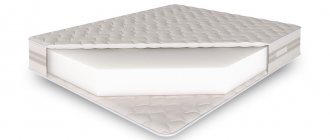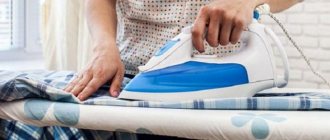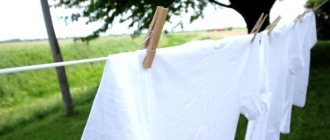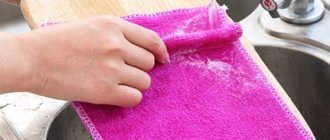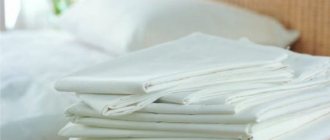Sleeping linen and bed
Different subtypes of laundry have their own characteristics when cleaning and washing. This section isn't just about bedding—cleaning the bed itself is just as important from a hygiene standpoint. It is advisable to synchronize the “big wash” of all bedding in the house once every few months to ensure that you get rid of possible insects or fungal problems.
Even clean-looking underwear can harbor parasites.
Video - Rules for caring for bed linen
Sheets
The biggest problem that arises when changing sheets infrequently is increased humidity. This is especially noticeable in summer and in hot climates, where it is advisable to change the bed every three to four days.
To care for your sheets, you need to remove the blanket from the bed every morning and ventilate the room to get rid of evaporation and unpleasant odors. You need to change your sheets at least once every ten days, and when washing, set the temperature to at least 60 degrees to destroy the larvae of dust mites.
Find out how to sew a sheet with an elastic band onto a mattress with your own hands in a special article on our website.
Mattresses
Surprisingly, the mattress is one of the easiest bedding items to clean. To clean the mattress you need to:
- Vacuum the upholstery.
- Remove it if possible. Vacuum the inside.
- Clean the inside of the mattress by hand using a cloth, cold water and a small amount of soap/shampoo.
This procedure must be repeated at least twice a year. In specialized stores you can purchase a special cover that will protect the mattress from dust mites and dirt.
Prices for mattresses
Mattresses
Pillows
Besides the obvious change of pillowcases once a week, you need to wash the pillows themselves. Similar surveys have not been conducted in Russia, but in Australia, for example, more than a quarter of residents have never washed their pillows. Hygiene doctors say that after a couple of years, an unwashed pillow contains a combination of mildew, dandruff, and live and dead mites. This mixture leads to chronic rhinitis and allergies, as well as eye infections.
To maintain cleanliness, pillows should be washed every three to six months. Feather filling requires dry cleaning; synthetic materials must be washed at 60 degrees or higher. Every two to three years the product needs to be replaced with a new one.
Feather pillow prices
Feather pillows
Blankets
The same risk group: constant contact with skin, sweat, high temperature. A dirty blanket is the most common carrier of mites after feather pillows, and the difficulty of washing due to its large size means that many people do not clean their blankets for literally years.
The hygiene rules are the same as for pillows - wash together once a quarter; blankets with down or any other natural filling are sent to the dry cleaner. Except that the service life of blankets is longer, up to five years.
Find out how to get rid of the smell in your washing machine at home in a special article on our website.
Prices for bed linen
Bed linen
Why do you need to change your underwear promptly?
During the period of use without cleaning, mattresses, pillows and blankets accumulate all the small debris that ends up in the bed. And sweat, dandruff, human hair and pet fur create an ideal environment for the activity of pathogenic bacteria and insect pests.
Accumulated microorganisms enter the body through pores, cause pathological processes and interfere with life. Entry through the respiratory system provokes irritation of the mucous membrane, suppression of the immune system, the development of an allergic reaction or the formation of asthma.
There are bed mites that are not visible to the naked eye, but are felt every night. Insects feed on human blood and can not only create uncomfortable conditions, but also cause severe harm to health.
Often washing all this is difficult, and even destructive for the things themselves, and dry cleaning is not cheap, you have to use pillowcases, duvet covers and sheets. They can be easily removed, washed and worn fresh. But even here the question arises of how long you can sleep on linen. The optimal frequency of replacement is calculated based on the characteristics of personal life, health, personal hygiene and everyday life.
Dependence on seasons
The recommended frequency of changing linen depends on the climate and weather outside.
The usual change of linen once a week is not enough to close the issue. The vast majority, nineteen out of twenty respondents, either wash their beds irregularly or do it on one convenient day of the week. This is not entirely the right approach - at different times of the year the human body produces different amounts of sweat, and the amount of skin lost also differs.
Important! The washing times here and below are given for people who shower daily before bed and regularly change their underwear. If a person ignores personal hygiene, then the bed needs to be changed one and a half to two times more often.
Winter
Thanks to low temperatures and switching to the heat retention mode, the sleeper produces much less sweat than under normal conditions. Microbiologists estimate the period by which linen changes can be reduced to two weeks. Of course, this does not apply to athletes and other people exposed to high physical activity every day.
Spring
The period of flowering and love, as well as the dark months for all allergy sufferers. If you have problems with allergies, then your underwear should be changed as often as possible, ideally once every five days. This will help calm the receptors at night with the absence of unnecessary odors and irritants. Sexually active couples should not delay changing their bedding - for them, changing once a week will be the necessary minimum.
Summer
Summer is a critical period, especially in the absence of air conditioning and in hot climates. Sweat, dirt, and skin particles accumulate on the bed and create an environment favorable for microorganisms. Here, fabric care is individual: somewhere in Sochi, sheets and pillowcases can be changed at least every three days, while in Vorkuta ten days will be quite enough.
Autumn
The only problem with cleaning clothes in the fall is dirt. Frequent rain, dust and slush place special demands on hygiene, so those who do not like to wash every day should wash more often. Autumn is the “hottest” period for the appearance of insects, so if there is any suspicion of the appearance of ticks, you must immediately take the entire bed to the dry cleaner.
For simplicity, you can use the following formula - we count the number of days after which you need to change your underwear in the summer, then multiply it by one and a half for spring/autumn and by two for winter. So, if in summer the bed becomes dirty after five days, then in winter it usually lasts for ten, and in the off-season, washing can be done every week. For a calendar, it is convenient to wash every 4-7-10-14 days, so as not to get confused in complex routines and complete the cycle every two or three weeks.
Washing rules and disinfection procedures
Sets made of calico, satin and other types of textiles will last for several years, will not shrink, will not come apart at the seams and will not fade if you follow simple care rules:
- Wash bedding separately from other items.
- Colored sets should be washed separately from plain ones. Do not mix products from several sets with different colors.
- Use the washing mode recommended by the manufacturer and indicated on the packaging or label.
- For everyday washing of lightly soiled laundry, use a temperature range of +40...+60°C. For delicate fabrics, set the water heating to +30...+40°C.
- Before washing, turn the garment inside out and remove any accumulated dust and threads from the corners.
- To disinfect linen and cotton fabrics, use the “boiling” mode.
- Remove stubborn stains with bleaches suitable for this type of textile. For undyed fabrics, use chlorine-containing preparations such as “Whiteness”; for fabrics with a printed pattern, use oxygen bleaches in the form of powder or liquid.
- Dry naturally at room temperature or in the fresh air.
- Be sure to iron. Use the mode appropriate for the type of fabric. For better smoothing and complete destruction of harmful microorganisms, use the steam function.
New bedding should be washed and ironed before first use. Treatment with water, detergents and high temperature will help clean the fabric from factory dust that has become embedded in the structure of the fibers during cutting, sewing and packaging. The first wash will rid the textile of paint particles and special preparations that are used by manufacturers to give the products a more attractive appearance.
Replacement features
Linen for sick and elderly people is changed every few days or daily.
Sometimes, the bed needs to be changed much more often than in standard cases. So, in case of colds, the linen must be changed to dry constantly, and after recovery, the entire bed goes into the wash. There are a number of important factors in which linen should be changed every five days:
- For people with oily skin, excessive sweating or dandruff problems;
- For those who watch TV in bed or eat there;
- If the bed is rarely made for the day, remaining in a disassembled state.
Athletes also have their own schedule. Accelerated metabolism and sweating leads to the fact that the bed becomes dirty a couple of days earlier. This is especially noticeable during the period of intensive preparation for the competitive season. Here, the desired “every week” often turns into the obligatory “every three to four days.”
Pets shorten the cycle to five days: the dog/cat's fur remains on the pillow, and the pet itself can be a carrier of any of thousands of diseases. At a minimum, dirt and vermin should cause replacement as often as possible.
Cleaning is required after the linen has been used by a guest. It also needs to be carried out after any large-scale procedures and rearrangements of the house - after repairs, even fine dust settles on well-closed pillowcases.
Dust mites: who are they and how to get rid of them?
These pets are in every home: they are not particularly afraid of either scorching heat or bitter cold, although the most comfortable temperature for them is from 20 to 30 degrees. Microorganisms rarely reach more than 0.5 mm in length; most of them cannot be seen without a microscope. In just one gram (on the tip of a pencil) of ordinary and boring house dust there can be up to 2500 of these creatures, and at least half of them will be different in appearance and type. By the way, science knows more than 3,000 species of these harmful little ones. A truly fascinating zoo delivered to your home!
How to wash clothes correctly
Options for markings on the bed linen label.
Note! The washing algorithm depends on the material and properties of the laundry itself; care details can be found on the label of the product itself. The following is general information that should not serve as a guide to action. An incorrectly selected mode can ruin a set of laundry, tearing it or destroying the color.
Video - How to wash clothes in a washing machine
Washing particularly dirty laundry begins with soaking. This can be done either manually, leaving the product in a container with soapy water, or using the soaking mode in the washing machine. Before you start washing, the laundry must be turned inside out.
The optimal temperature for washing white laundry is 60 degrees: this will kill most insects and clean even the most serious stains. There is no need to boil bed linen - this will cause it to lose strength and quickly tear. Colored linen is washed at a lower temperature of 40 degrees. In the process, it is advisable to use special washing powders for colored laundry.
Silk and other luxury fabrics stand apart - they are washed in a delicate mode or by hand, without squeezing. Silk linen requires special washing conditions and deteriorates quickly, so you should use it as little as possible.
Important! Don't forget to wash your laundry immediately after purchasing. This will not only rid it of the dirt that has accumulated during the journey from the manufacturing factory, but will also wash away the special exhibition composition. This composition is used to give the fabric rigidity and presentation. After the first wash, the laundry will become softer and ready for use.
When washing clothes in a washing machine, it is necessary to take into account its average weight.
Table 1. Average weight of bedding sets
| Bedding sets | Average weight |
| Children's set | 1200 grams |
| One and a half | 1600 grams |
| Double | 1900 grams |
| Eurostandard | 2300 grams |
Table 2. Weight of cotton linen individually
| Cotton product | Weight |
| Pillowcase | 200-250 grams |
| Sheet | 500-600 grams |
| Duvet cover | 800 grams |
Weight depends on the size of the product and its material. Typically, a five-kilogram washing machine is enough to clean the entire set of bed linen, towels and pajamas for two people.
Prices for popular models of washing machines
Washing machines
How to starch laundry - step-by-step instructions
Fabric soaked in starch not only becomes more tensile and looks brighter. Starch also protects the fabric from dirt, and most stains disappear during washing, being applied to a solid film.
In addition to its beautiful appearance, starched linen is also more hygienic.
The procedure itself is divided into three types, soft, medium and hard.
Table 3. Step-by-step instructions for preparing the starch mixture
| Steps, description | Photo |
| Step 1. Take a spoonful of starch and some cold water. |
|
| Step 2. Pour into one container and stir until smooth. |
|
| Step 3. Add the dissolved mixture to a liter of boiled water. |
|
For medium starch, take a tablespoon of the substance; for hard starch , take two tablespoons and add a teaspoon of borax.
Clean bedding is soaked and rinsed in the resulting liquid. Then the item is wrung out and straightened so that there are no wrinkles on it. There is an easier way - the mixture is sprayed onto the fabric with a spray bottle.
Ironing
A procedure that requires special endurance and patience, but it pays off with the almost sterile cleanliness of the tissue. If any bacteria survive after washing, ironing and steaming will finish them off completely.
Important : not all types of laundry can be ironed at maximum temperature. The exception is silk sheets and combined sets that require an individual approach. First you need to carefully study the sewn-on leaflet with instructions.
Another advantage of ironing is the ease of further folding for storage. But if you don’t have time to process the entire sheet or duvet cover, which is not so easy to iron properly due to its size, it is enough to steam only the edges.
- Calico - ironed slightly moistened with water or in a damp state.
- Satin is easy to iron because it doesn’t form a lot of wrinkles after washing. But you can only iron it dry, from the inside.
- Cotton is ironed on both sides.
- Silk is ironed wet from the inside out.
- The chintz is ironed from the face, having previously been sprayed with water from a spray bottle.
- It is better to touch synthetic materials with an iron through gauze and only when dry.
Other types of linen
When touching on personal hygiene issues, one cannot ignore towels, pajamas and underwear. They may not directly relate to the issue of bedding, but they are very, very close.
Towels used after an evening shower should be washed regularly.
Underwear
One of the dirtiest items of clothing. Even visually clean panties contain up to 10,000 bacteria and microorganisms. If you don’t change your underwear within one day, a couple of zeros will be added to this number. This applies to all types of clothing, from thongs to boxers.
Doctors recommend changing underwear every day, and completely replacing the item once a year. When washing in a machine, use a temperature of 30-40 degrees using bleach or any similar additive. If one of the family members is sick, it is better to wash at a temperature of 60 degrees - this will destroy most microorganisms.
Pajamas
Many people do not consider pajamas and dressing gowns as underwear, washing them much less often than they should. Anonymous surveys say that pajama lovers wear them for more than two weeks before putting them in the wash, and women are even more dirty in this case: 17 days without washing versus fourteen for men.
It should not be forgotten that pajamas require cleaning at least once a week, with washing machine settings identical to underwear. Of course, as with underwear, the washing cycle depends on the manufacturer's recommendations on the label.
Towels
It is towels that remove most of the dead skin cells from our body. They are the ones who collect bacteria and microorganisms from the upper layer. The warm and humid atmosphere of the bathroom ensures that skin viruses and fungi have their chance to become infected.
Microbiologists say that a towel should be washed immediately after three uses. The overall service life depends on the frequency of replacement, but with active use it is advisable to purchase a new towel annually.
Attention! Never allow strangers to use your towel! Even boiling does not always guarantee complete cleaning of the product.
When cleaning, high temperatures are required (60 degrees and above) , as well as the additional use of antibacterial agents.
The dangers of dirty laundry
If you look under a microscope at the structure of the fabric that was used as a pillowcase for two weeks, you can find:
- mold - formed due to dampness from sweat, wet hair after a shower and transferred by spores from other sources;
- plant pollen - flying in from an open window or falling from a flowerpot when one is standing nearby;
- wool, helminths or parasite eggs - if there are pets in the house;
- keratinized skin cells not only of the person who directly used the item, but also of the person who slept next to or approached the bed;
- discharge from sweat glands;
- remnants of decorative cosmetics, face cream, hand cream.
Sleeping on clean linen is good for your health and just feels good for your body. But, as mentioned earlier, each fabric requires a special approach. If you don’t want to bother with this, it’s better to purchase bedding from the same material.
Parasites in bed linen
The main difficulty in caring for laundry and doing weekly laundry is convincing the person that he needs it. After all, billions of people don't wash their pillowcases once a week and humanity still hasn't gone extinct, right?
Parasites living in the bedroom
Bacteria
The US Microbiology Association decided to conduct an experiment by randomly collecting 50 pillows from students in dormitories at 25 colleges. The sample was quite representative: from students of elite institutions to ordinary colleges. The results surprised even the researchers themselves: on average, each pillow contained about 300 thousand bacterial foci and more than 90 thousand fungal accumulations.
This is what professional mattress disinfection looks like
The most popular pathogens in the hit parade were:
- Bacteria from the nasopharynx, which cause bronchitis and lung diseases;
- Fungi that provoke an allergic crisis;
- Dysentery stick.
Despite the fact that women turned out to be a little more careful than men (the number of pathogens on average was one and a half times less), a “gentleman’s set” was also found among them. The record sample was a student's pillow with more than 150 million bacteria and fungi.
Under normal conditions, most of these harmful agents are not dangerous—the immune system successfully fights them. But as soon as he weakens, permanent illnesses will not keep him waiting.
What to do? Heat treatment is good for getting rid of bacteria and viruses - simply ironing clothes will destroy almost everything that can be found inside.
Dust mite
Enlarged image of a dust mite.
If lazy people who don’t like washing and ironing have now given up and thought “oh, I have excellent immunity, this will do” - then in the picture above you can see the second scourge of dirty bed linen, the dust mite.
The tick loves the bed itself most of all, living in the mattress, blankets or pillow. These parasites are invisible to the eye and affect a person indirectly, intensifying his current diseases. Ticks can cause the following diseases or their complications:
- Allergy attacks;
- Diseases of the nasopharynx, including chronic ones;
- Skin diseases, irritation, itching;
- Cough and runny nose.
In addition, ticks will become a problem in cases of serious lung diseases, such as pneumonia or asthma.
Fun fact : According to a study published in the Journal of Medical Entomology, ticks prefer red underwear because of a biological program embedded in them. Blue linen, even if only slightly, will reduce the number of these parasites in your bedroom.
Ideal conditions for these parasites: relative humidity above 60%, high temperature, dirt. During her month-long life cycle, the female will give birth to up to 30 cubs, and the male will leave deposits 200 times larger than himself. It has been observed that in just a decade the weight of a mattress will double if not used carefully due to dust, mite remains and feces.
What to do? Regular wet cleaning, maintaining a dry atmosphere in the apartment and cold will help against ticks - just a few hours on the winter balcony and most of the ticks in your favorite blanket will die, and the rest will hibernate.
Fungus
The fungus, having settled in the bed linen, eats into it tightly.
Fungal diseases are among the most common on the planet - about one and a half billion people suffer from mycosis of the extremities. The easiest way to become infected with fungus is in common areas: swimming pools, saunas, gyms. Next, the microorganism spreads through your laundry to the rest of your family members.
At risk are people with weakened immune systems, diseases of the cardiovascular system and vitamin deficiency. It is impossible to completely protect yourself from fungus, but to reduce the likelihood of illness, do not use other people's things and change linens as often as possible if you have to share the bed with a sick person.
What to do? Fungi, like all microorganisms, love warmth. At the same time, it survives well in the cold, so the method of taking things out into the cold will not work here. In order to get rid of fungus on things, you need to use washing in combination with boiling. In extreme cases, wear socks everywhere, including in bed.
What influences the frequency of changing linen
The intensity of changing bed linen depends on a number of factors:
- age;
- individual characteristics;
- fabric type;
- season;
- number of people sleeping;
- place of sleep organization.
Housewives should know that children's underwear should be changed more often. This is especially true for newborns and teenagers.
Researchers say you should wash your sheets, pillowcases, duvet covers and even pajamas at least once every two weeks.
Each person has his own individual characteristics. This is the degree of sweating, various diseases, etc. Bedding for a sick person is changed almost daily.
Some people like to bed train their pets. During shedding, cats and dogs lose a lot of hair. Even if they do not sleep on the bed, the hairs of their coat settle on various objects.
A pet in the owner's bed is a common occurrence.
Changing linen also depends on the characteristics of the fabrics; they are not equally susceptible to contamination. When choosing a sleeping set, you need to inquire about the properties of the material.
More dust accumulates in synthetics, but it is less polluted. Natural fabrics require frequent washing.
Bedding made from fragile material should not be washed frequently. They will soon become unusable and lose their original appearance. In this case, it is better to have several sets of linen.
Pollution visible to the eye is nothing compared to the danger that lurks at the level of microorganisms.
The rate of pollution depends on the time of year. In summer, people sweat more often, even when they sleep. It is advisable to change linen every 7 days. In winter, this can be done less often.
The cleanliness of the bed also depends on the number of people sleeping on it. One person is less likely to soil a bed than two. What a person sleeps in is also important. If you wear pajamas or a nightgown, your underwear will get dirty less.
People sleep not only at home, but also in kindergartens, hospitals, sanatoriums, etc. Compliance with hygiene rules in public organizations also has its own requirements. They create tables for changing bed linen.
When purchasing a set of linen, give preference to natural fabrics.
Violations of sanitary standards lead to various diseases. Parents are concerned about the frequency of changing bed linen in the kindergarten their child attends.
According to SanPiN, the procedure for changing linen in a preschool institution occurs at least once a week. In children's hospitals they are required to change it once every 7-10 days or as needed.
Synthetics contribute to excessive moisture formation, which is a beneficial environment for microorganisms.
